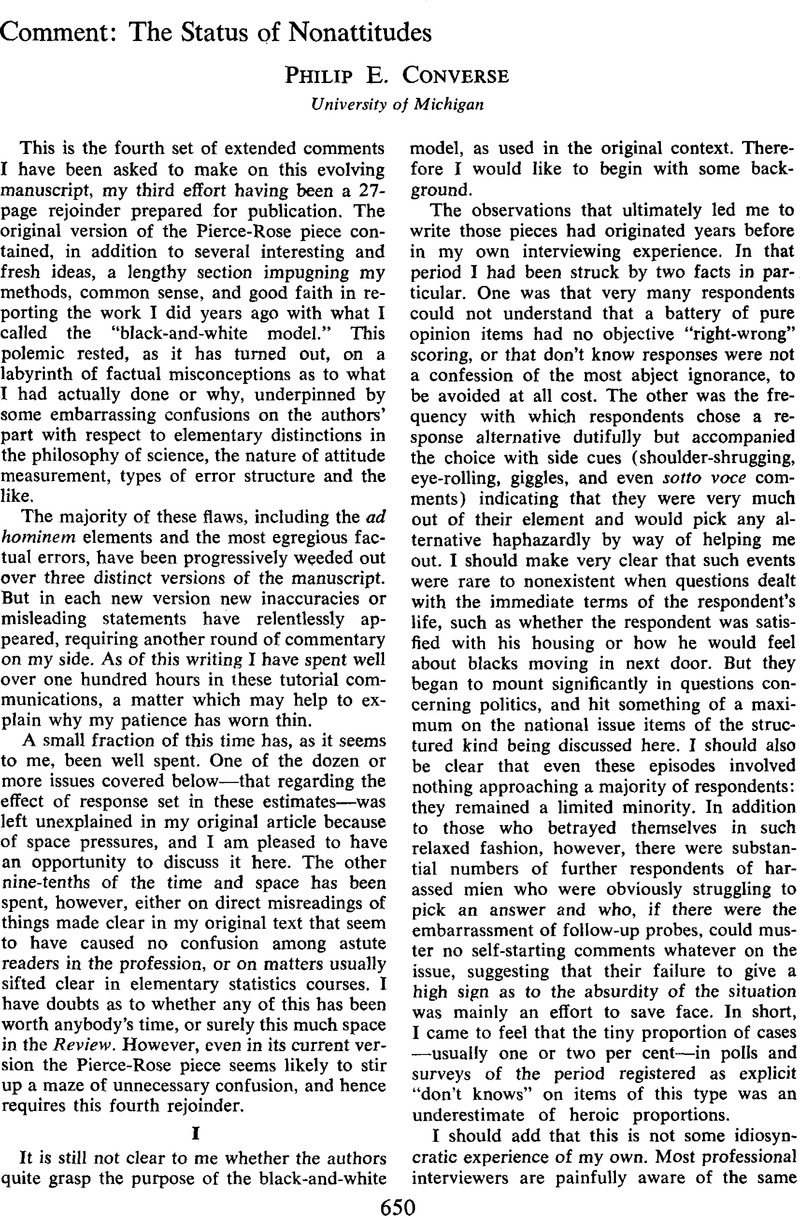Published online by Cambridge University Press: 01 August 2014

1 I assume, for example, that most readers would take the footnote phrase of Table 4 referring to “correlations between attitudes on a question in the two samplings” to mean a correlation formed on the set of apparent content responses (ranging from strong-agree to strong-disagree) at two successive administrations. The reader should be advised, however, that the square of the latter type of correlation for the public power item is not 99%, but somewhere in the vicinity of 10%. A number of the other items, like school integration, run higher, although probably none exceeds 25% and few exceed 20%. In other words, the quanta presented in Table 4 are not what most readers would believe, and frankly I recognize them only from my own lengthy work on the problem. Ironically, in using these estimates, the authors are much closer to accepting the logic of the black-and-white model than they appear to understand.
2 Earlier versions of the Pierce-Rose manuscript were extremely exercised over my decision to work with this dichotomization of the sample. The authors felt that once into a partitioning game any change of position, even from “strong” to “weak” on the agree side, must be counted as a nonattitude. They also insinuated that by using a dichotomy in the critical correlational test, I was trying to hide a non-fit that would have shown through because of an edge of stability in the weak-strong choice within a side of the issue. The latter allegation was easy to dispose of, since in fact the correlational test was not performed dichotomously, but rather on the four-by-four table using the strength differentiation. This left the authors complaining about the original dichotomy, and in my third review I laid out my several reasons for deciding this was the wisest procedure. However, this current version of the Pierce-Rose manuscript, revised with those reasons in hand, seems to have largely if not completely subsided on this issue. Therefore to save space, I will not reiterate those reasons here, but I would be glad to mail anybody concerned about the matter a copy of my third review.
3 The authors' response to criticism of the vulnerability of their model to response set has been mainly made up of the addition of Appendix II, in which they set out to show that the black-and-white model does not perform well with items where sharper response sets than the power and housing item encounters are involved. The Appendix is largely irrelevant, since these other items are the ones where the black-and-white model should not be used in any event, not because of response set intrusion, but because of failure of these items to meet the “no change in true attitude” assumption necessary for the model. Moreover, a crucial proposition in that Appendix—to the effect that the standard form for the five issue items should mean a standard degree of response set—is well-known not to be true among scholars who have looked into these matters at all closely. In general, this Appendix is one of several reasons why I have had trouble building confidence that the authors really have much understanding either of the black-and-white tests or of the several deeper measurement issues involved.
4 Given what we have said about the “lumpiness” and cross-time inertia of these items, the reader should have no trouble seeing why the other tests of “goodness of fit” (Tables 7 and 8) are no more impressive than Table 6.
Comments
No Comments have been published for this article.